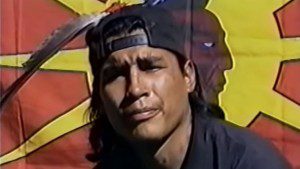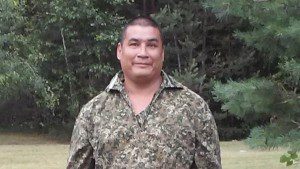(A screen grab of the truck James “OJ” Pitawanakwat was driving on Sept. 11, 1995, moments before it hit an RCMP IED during the Gustafsen Lake standoff. YouTube)
Jorge Barrera
APTN National News
A Wikwemikong man who was given political asylum in the U.S. following the 1995 Gustafsen Lake armed standoff in British Columbia wants to return to Canada.
James “OJ” Pitawanakwat, 44, has lived in the U.S. since August 1998 when he crossed the border while on day parole in Canada.
The U.S. Federal Court for the District of Oregon denied Canada’s extradition request for Pitawanakwat in November 2000 on grounds his actions in B.C. were “of a political character” and qualified for an exemption under the extradition treaty between Canada and the U.S.
“I would like to go back home to live and come and go throughout Canada and come and go throughout the U.S. without this harassment,” said Pitawanakwat, who is originally from Wikwemikong on Manitoulin Island in Ontario.
He said there is still an active warrant out for his arrest in Canada.
Pitawanakwat was convicted by a B.C. court in 1997 of mischief and possession of a weapon for a purpose dangerous to the public peace in connection to his involvement in the summer standoff which saw more gunfire exchanged between warriors and police than during the 1990 Oka Crisis.
He was sentenced to three years in prison, but was released on day parole after one year. Nine days into his day parole, Pitawanakwat, who was in Surrey, B.C., at the time, said he “just walked right across” the U.S. border. As a First Nation man, Pitawanakwat can legally live on both sides of the border.
“I eventually started going across American and showing people the video of the truck explosion,” said Pitawanakwat.
(John “Splitting the Sky” Hill describes explosion triggered by RCMP IED. YouTube)
The video of the truck explosion is one of the most striking images of the Gustafsen Lake standoff. It was Sept. 11, 1995, and Pitawanakwat was driving with a woman activist, an AK-47 along with a rifle inside the pick-up truck, his dog Idaho in the back. They were roaring down a logging road when they hit an RCMP installed improvised explosive device (IED). The truck flipped in a plume of dirt and smoke, Pitawanakwat and the woman managed to escape the vehicle, but Idaho was shot by an RCMP sniper.
“I remember driving down the road and then an explosion just rocked my world and disorientated me for a quick minute and my combat senses kicked-in and survival set in,” he said. “I relive that moment every day of my life.”
Pitawanakwat said he and the activist managed to cross the lake where a cache of weapons was hidden. Some of the other warriors also arrived and began to open fire on the RCMP’s Bison armoured personnel carrier, borrowed from the Canadian Forces.
“When I reached the treeline I armed myself and returned to the guts of the conflict on the battle field. The armoured personnel carrier was disabled by small arms fire and by the trees. It knocked out the steering column,” he said. “We just put suppression fire on the other Bison when it started roaring out of nowhere and was shooting people. It was straight out war.”

The Gustafsen Lake standoff centred on land leased by the province to a rancher near 100 Mile House, B.C., that was used for Sundance ceremonies. The land, which was never surrendered, was reclaimed by the Ts’Peten Defenders in 1995 who refused to leave despite attempts by the rancher to evict them.
The RCMP intervened, and, with support from the Canadian Forces, faced down the Ts’Peten Defenders, who numbered between 30 to 40 people, according to the U.S. Federal Court record.
Things escalated in mid-August when Defenders spokesperson William “Wolverine” Jones Ignace said if the RCMP moved into the camp it would be “clearly war…We’re not going to go peaceful. Body bags or do a hell of a long stretch…Nobody is going to tell you to put your weapons down,” according to the court record.
The RCMP and the Canadian Forces, working through Operation Wallaby, set up a base camp called Camp Zulu which included armoured personnel carriers, helicopters, a field hospital, communication centre, military assault weapons and a tactical unit of about 400 “heavily armed militarized police,” according to U.S. court records.
After several incidents, which saw tens of thousands of rounds exchanged between both sides, the Defenders’ camp surrendered by Sept. 17, 1995.
There were 18 people, 13 men and five women, at the camp by the stand-off’s end. All 18 were convicted by a jury following a 10-month trial, according to the U.S. court record.
Despite Canada issuing a warrant for his arrest shortly after he fled across the U.S. border, Pitawanakwat managed to evade capture for a little less than two years.
He was finally arrested in Lincoln City, Ore., in June 2000, after he went out to buy pizza on his bicycle.
“I found out U.S. Marshals were on my tail. One morning they swooped in and got me,” he said. “They converged on me, on my bike and I fled into the thorns. They arrested me and took me to Portland, Ore.”

U.S. Federal Court Judge Janice Stewart, however, denied Canada’s request for extradition, ruling that Pitawanakwat’s activities at Gustafsen Lake qualified for exemption under the extradition treaty for activity of “a political character.”
“The Lake Gustafsen incident involved Indigenous people rising up in their own land against the government of that land. Although the crimes were committed while trespassing and occupying private property, the type of property occupied makes this case unique,” said Stewart, in her ruling. “(The rancher) acquired title to the land through the Canadian government, but this land included tribal land over which Native people believed they had a valid legal claim. Thus, the protest by the Ts’Peten Defenders was directed largely against the Canadian government which had granted (the title)…In addition, the violence was aimed…at the Canadian government and its military forces.”
Pitawanakwat was preparing to find a lawyer to help build his case for a final return to Canada earlier this year, but tragedy struck his life in Mount Pleasant, Mich., when his step-son attacked both his mother and Pitawanakwat with a knife.
Juan Romero, 22, is accused of stabbing his mother in the face. Pitawanakwat said he was stabbed seven times. Local reports say he was flown to hospital with multiple stab wounds.
Romero is currently undergoing a psychiatric assessment and his case is on hold, according to an Isabella County court official. Romero is facing two counts of assault with intent to murder, among other charges.
Pitawanakwat was also hit with a sexual assault related charge shortly after the incident, but the case was dismissed on Sept. 10, 2015, according to a court official.
“The prosecuting attorney was not ready to proceed with the case,” said the court official.
The prosecutor Robert Holmes did not return a call seeking comment.
Pitawanakwat’s desire to return to Canada is getting support from one of the most prominent members of the Gustafson Lake standoff, Secwepemc Elder “Wolverine” Ignace.
Wolverine recently wrote Prime Minister Justin Trudeau and Justice Minister Jody Wilson-Raybould a letter requesting they call a public inquiry into the events of the 1995 standoff.
“Such an inquiry would expose the Canadian government’s genocidal relationship with Indigenous peoples,” said Wolverine, in an emailed response to questions from APTN. “Specifically, the cover-up of the genocidal actions of the federal provincial government during the Ts’Peten-Gustafsen standoff of 1995.”
Wolverine said he hoped an inquiry would help allow Pitawanakwat to return home.
“James has been in exile for 20 years,” he said. “As an Indigenous man, he has the right to come home. He is an adopted member of (Wolverine’s family), of the Secwepemc Nation as a whole.”
Wolverine has also called for a gathering of “Allied” Tribes to meet on Sunday in Secwepemc territory to discuss the recent call for a national inquiry into the 1995 standoff and Pitawanakwat’s return.
[email protected]
@JorgeBarrera










